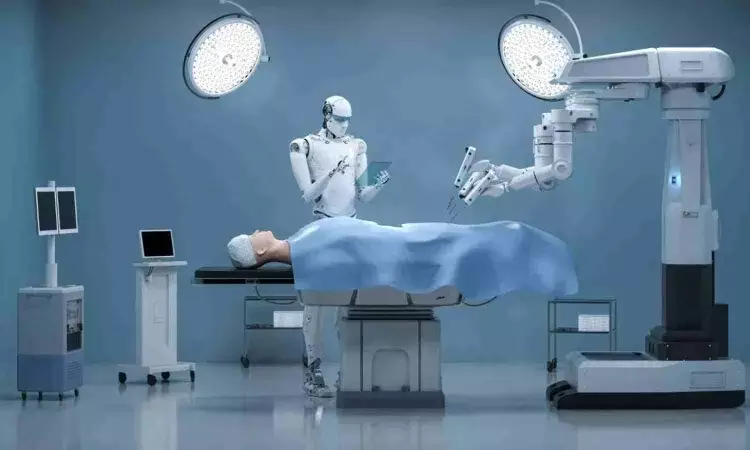- Home
- Medical news & Guidelines
- Anesthesiology
- Cardiology and CTVS
- Critical Care
- Dentistry
- Dermatology
- Diabetes and Endocrinology
- ENT
- Gastroenterology
- Medicine
- Nephrology
- Neurology
- Obstretics-Gynaecology
- Oncology
- Ophthalmology
- Orthopaedics
- Pediatrics-Neonatology
- Psychiatry
- Pulmonology
- Radiology
- Surgery
- Urology
- Laboratory Medicine
- Diet
- Nursing
- Paramedical
- Physiotherapy
- Health news
- Fact Check
- Bone Health Fact Check
- Brain Health Fact Check
- Cancer Related Fact Check
- Child Care Fact Check
- Dental and oral health fact check
- Diabetes and metabolic health fact check
- Diet and Nutrition Fact Check
- Eye and ENT Care Fact Check
- Fitness fact check
- Gut health fact check
- Heart health fact check
- Kidney health fact check
- Medical education fact check
- Men's health fact check
- Respiratory fact check
- Skin and hair care fact check
- Vaccine and Immunization fact check
- Women's health fact check
- AYUSH
- State News
- Andaman and Nicobar Islands
- Andhra Pradesh
- Arunachal Pradesh
- Assam
- Bihar
- Chandigarh
- Chattisgarh
- Dadra and Nagar Haveli
- Daman and Diu
- Delhi
- Goa
- Gujarat
- Haryana
- Himachal Pradesh
- Jammu & Kashmir
- Jharkhand
- Karnataka
- Kerala
- Ladakh
- Lakshadweep
- Madhya Pradesh
- Maharashtra
- Manipur
- Meghalaya
- Mizoram
- Nagaland
- Odisha
- Puducherry
- Punjab
- Rajasthan
- Sikkim
- Tamil Nadu
- Telangana
- Tripura
- Uttar Pradesh
- Uttrakhand
- West Bengal
- Medical Education
- Industry
Robotic-assisted surgery and navigation do not alter the risk of PJI after total hip replacement surgery

Robotic surgery
For patients undergoing total hip arthroplasty (THA), the use of robotic-assisted surgery and surgical navigation techniques is not associated with an increased risk of periprosthetic joint infection (PJI), suggests a study in The Journal of Bone & Joint Surgery. The journal is published in the Lippincott portfolio by Wolters Kluwer.
Computer navigation (CN) and robotic assistance (RA) do not alter the risk of PJI after total hip replacement surgery, according to the new research by Alberto V. Carli, MD, and colleagues of Hospital for Special Surgery, New York.
Could CN and RA increase risks during hip replacement?
Computer navigation and robotic assistance are increasingly used during THA. These technologies have shown beneficial effects, including more accurate component positioning and a lower risk of postoperative instability. However, "[I]t remains unknown as to whether use of [CN and RA] leads to an improvement in long-term functional outcomes or implant longevity," according to the authors.
The use of CN and RA requires the presence of additional equipment and personnel in the operating room, and has been linked to longer operating times. Together, these factors might lead to an increased risk of surgical-site contamination and PJI, a major cause of implant failure after THA.
Dr. Carli and colleagues analyzed their hospital's experience of nearly 13,000 patients undergoing primary THA between 2018 and 2021. During this time, CN was used during THA in 21% of patients and RA in 16%. The remaining 63% of patients underwent conventional THA without CN or RA.
Similarly low rates of PJI, with or without new technologies
Using a technique called propensity-score matching, the researchers identified groups of patients with similar risk factors undergoing THA by conventional methods or with the use of RA (2,003 patients in each group) or CN (2,664 patients in each group). Ninety-day rates of PJI were compared between groups, with adjustment for other factors.
Both technologies were associated with small increases in operative times, compared to conventional THA: two minutes longer with CN and 11 minutes longer with RA. Previous studies have raised concerns that longer surgical times might lead to increased risk of complications.
However, in the new study, the incidence of PJI was similar among groups: 0.4% for both CN and RA compared with rates of 0.2% and 0.4% for the respective propensity-matched conventional THA cohorts. In adjusted analyses, there were no significant differences in PJI risk.
“Although computer navigation and robotic assistance are currently used in a minority of THA procedures, the increase in the use of such technology appears to be inevitable in the coming decades," the researchers write. Their study adds new evidence that, in matched groups of patients with similar characteristics, the risks of PJI are comparable, with or without the use of CN or RA.
The authors point out some limitations of the study-notably including the overall low rate of PJI at their specialized, high-volume orthopaedic surgery center. Dr. Carli and coauthors conclude: "While the long-term clinical, functional, and implant-longevity outcomes associated with the use of computer navigation or robotic assistance remain to be elucidated, the findings of the present study are reassuring with respect to the risk of infection."
Reference:
LaValva, Scott M. MD1; Chiu, Yu-Fen MS2; Fowler, Mia J. BScH1; Lyman, Stephen PhD1; Carli, Alberto V. MD1,a. Robotics and Navigation Do Not Affect the Risk of Periprosthetic Joint Infection Following Primary Total Hip Arthroplasty: A Propensity Score-Matched Cohort Analysis. The Journal of Bone and Joint Surgery ():10.2106/JBJS.23.00289, February 7, 2024. | DOI: 10.2106/JBJS.23.00289.
Dr Kamal Kant Kohli-MBBS, DTCD- a chest specialist with more than 30 years of practice and a flair for writing clinical articles, Dr Kamal Kant Kohli joined Medical Dialogues as a Chief Editor of Medical News. Besides writing articles, as an editor, he proofreads and verifies all the medical content published on Medical Dialogues including those coming from journals, studies,medical conferences,guidelines etc. Email: drkohli@medicaldialogues.in. Contact no. 011-43720751


